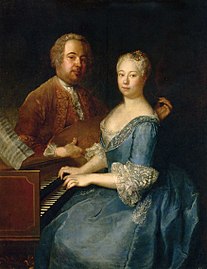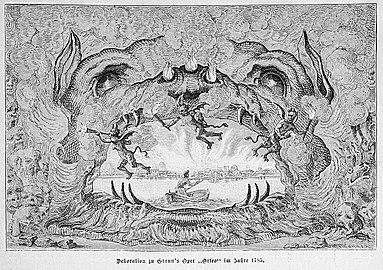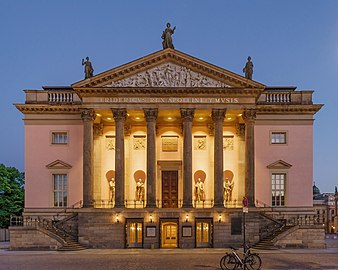Graun monument
The Graun memorial stands on Graunplatz in the district of Wahrenbrück in the small town of Uebigau-Wahrenbrück in the Elbe-Elster district in southern Brandenburg . It is reminiscent of the musician Carl Heinrich Graun (1704–1759) who was born in Wahrenbrück . The monument created in 1869 is included in the list of monuments of the state of Brandenburg.
Description and history
Carl Heinrich Graun
The picture shows the musician Carl Heinrich Graun (1704–1759), who was born in Wahrenbrück . Graun was a graduate of the Dresden Kreuzschule . After his studies he was called to Braunschweig as a court singer . He was finally obliged by the Prussian Crown Prince Friedrich and remained in his service even after his rise to the position of Prussian King. In the following years he celebrated numerous successes as a singer and composer , which made him well known and popular at the time . Carl Heinrich Graun was considered "the best dramatic singer of his time". The Royal Court Opera in Berlin , today “Staatsoper Unter den Linden” (also: “Deutsche Staatsoper Berlin”) opened on December 7th, 1742 with Graun's opera Cesare e Cleopatra . However, his best-known work is the Passion Oratorio Der Tod Jesu , which he created and which was one of the most popular Passion Oratorios in the 18th and 19th centuries and, after its premiere in 1755, was the most frequently performed Protestant Passion music in Germany .
The 23-year effort for the monument in the 19th century
The monument is a bronze bust on a pedestal of granite .
The history of the erection of the monument in honor of Carl Heinrich Graun in Wahrenbrück in 1869 goes back more than twenty years. As early as 1846 there were considerations in the small town on the Schwarzen Elster to commemorate their once popular son. Both a memorial and a charitable foundation to promote talented music students were envisaged. In the same year, planning and the collection of appropriate financial resources began. The Wahrenbrück deacon Fürnrohr and the city mayor Catholy therefore submitted a petition to the Prussian king in order to obtain financial support in the form of a corresponding gift of grace . Carl Loewes (1796–1869) oratorio The Seven Sleepers was performed in the parish church in order to collect donations. The campaign raised 37 thalers, 11 silver groschen and 4 pfennigs .
Twelve years after the initial deliberations, in 1858, eight chestnut trees were planted to mark the place in the middle of which the monument was to stand. In the following year it was decided to refrain from a foundation and to concentrate on the erection of the monument. Thereupon the then mayor Engelhard and the city councilor Burkhard undertook trips to Berlin and Merseburg in order to acquire further financial means. 119 thalers were raised through their efforts. In addition, a Professor Preiss compiled the life story of Graun free of charge. The drawing of the planned monument by the Berlin court building officer, Strack, was also free of charge.
A committee made up of twelve citizens from Wahrenbrück and twelve from Liebenwerda each took care of the procurement of further financial resources for the monument from 1860 onwards. The Wahrenbrück cantor Wießner and the Liebenwerda rector Jülich were responsible for the execution of the business. In the next few years a further 1,404 marks and 50 pfennigs could be obtained through various events and collection campaigns from local associations.
The foundation stone was laid on September 19, 1867 and two years later - 23 years after the first efforts - it was finally done on June 20, 1869. The monument in honor of Carl Heinrich Graun was erected in its current location opposite the former location of his birthplace in the city center of Wahrenbrück. Ultimately, the cost was 1,681 marks. The bronze bust was cast by the Lauchhammer art and bell foundry ; the granite required for the base was obtained in Dresden and the foundation stone in Strehla .
The Graun brothers and other commemorations
The city of Wahrenbrück is closely linked to the life and work of the Graun brothers who were born here . The parish church in Wahrenbrück is considered to be their baptistery. In addition to Carl Heinrich Graun, the brothers are the composers August Friedrich Graun (1698 / 99–1765) and Johann Gottlieb Graun (1703–1771). The eldest of the brothers worked for many years in Merseburg as cathedral choirmaster and was relatively unknown. The two younger brothers, on the other hand, were quite successful in their day. You are one of the main representatives of the First Berlin Song School .
In addition to the Carl Heinrich Graun monument in Wahrenbrück, the Graun Society Wahrenbrück association founded in 2010 commemorates the brothers. The Wahrenbrücker Ratskeller is currently being renovated as the future Graunzentrum . In Bad Liebenwerda , a few kilometers away, there is a permanent exhibition on the life and work of the Graun brothers in the local district museum . In the Gesundbrunnen district of Berlin city center, Graunstraße is reminiscent of Carl Heinrich Graun.
Web links
Notes and individual references
- ↑ a b Database of the Brandenburg State Office for the Preservation of Monuments and the State Archaeological Museum ( Memento of the original from December 9, 2017 in the Internet Archive ) Info: The archive link has been inserted automatically and has not yet been checked. Please check the original and archive link according to the instructions and then remove this notice. , accessed November 5, 2017.
- ↑ a b c d e R: The Graun Monument in Wahrenbrück . In: The Black Magpie . No. 116 , 1909 (free local history supplement to the Liebenwerdaer Kreisblatt ).
- ^ Georg Dehio: Handbook of German Art Monuments - Brandenburg . 2nd Edition. 2012, ISBN 978-3-422-03123-4 , pp. 1134 .
- ↑ a b City Administration Uebigau-Wahrenbrück (ed.): “Living together in Uebigau-Wahrenbrück” (information brochure, pdf), 2016
- ↑ Erich Schindler: "Preserved in the tower button" in "Home calendar of the Bad Liebenwerda district" . 1993, p. 91 to 93 .
- ↑ Internet presence of the Graun-Gesellschaft Wahrenbrück , accessed on November 5, 2017
Coordinates: 51 ° 33 ′ 0.8 ″ N , 13 ° 21 ′ 48.8 ″ E







